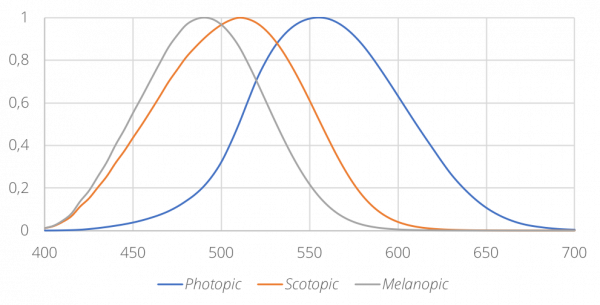
Light Measurement Requirements for Human Centric Lighting
Contemporary scientific research has shown that in addition to the cones and rods that provide us with color and night-time vision respectively, our retinas also have non-image forming photoreceptors, called intrinsically photosensitive retinal ganglion cells (ipRGCs), which play a major role in entraining our circadian rhythms. Of particular interest is the spectral responsivity of ipRGCs which contain a photopigment called melanopsin. Whereas our cones and rods have spectral responsivities defined by the V(λ) and V’(λ) functions for photopic and scotopic vision, ipRGCs have their own ‘melanopic’ spectral responsivity with peak sensitivity in the blue spectral region, around 480nm.
SSL Possibilities for HCL
Modern insights into human chronobiology combined with the possibilities of SSL lighting offer many new opportunities to improve health and wellbeing through appropriate lighting, most commonly referred to as ‘human centric lighting’ (HCL), but other terms such ‘circadian lighting’, ‘biodynamic lighting’ or ‘biologically-effective lighting’ are also regularly used.
In its basic form, HCL typically attempts to control the Correlated Color Temperature (CCT) of lighting in a way that emulates natural daylight. More sophisticated techniques involve the measurement of additional metrics such as melanopic illuminance (CIE TN 003:2015) [1] or Circadian Stimulus (LRC Rensselaer) [2]. The accurate measurement of all of these metrics requires spectral characterization of the lighting.
The measurement of ‘equivalent melanopic lux’ (EML or melanopic illuminance), as required by the WELL Building Standard [3] for example, and ‘melanopic daylight equivalent illuminance’ are standard features of all our spectral light meters, including the low cost MSC15-CS meter which is approved by the International WELL Building Institute for such measurements.


Works with WELL TM licensed by International WELL Building Institute

HCL Measurement Systems
HCL is not only concerned with our ipRGC response to the amount and timing of ‘blue light’ received. Rod and cone photoreceptors also contribute to our circadian phototransduction. Knowledge of other wavelengths may also prove useful to HCL designers. For example, ‘red light’ has been shown to increase alertness without suppressing melatonin. For research purposes, the CIE now recommends (CIE TN 003:2015) [1] reporting all of the 5 α-opic equivalent illuminances for s-cones, m-cones, l-cones, rods and ipRGCs. Accordingly, the BTS256-EF spectral light meter and the BTS2048-VL laboratory spectroradiometer report the following metrics:
| α-optic |
| unit |
| Ez | melanopic illuminance | z-lx |
| Ee,z | melanopic irradiance | W/m² |
| Ev,mel | melanopic daylight equivalent illuminance | lx |
| Esc | cyanopic illuminance | sc-lx |
| Ee,sc | cyanopic irradiance | W/m² |
| Emc | chloropic illuminance | mc-lx |
| Ee,mc | chloropic irradiance | W/m² |
| Elc | erythropic illuminance | lc-lx |
| Ee,lc | erythropic irradiance | W/m² |
| Er | rhodopic illuminance | r-lx |
| Ee,r | rhodopic irradiance | W/m² |